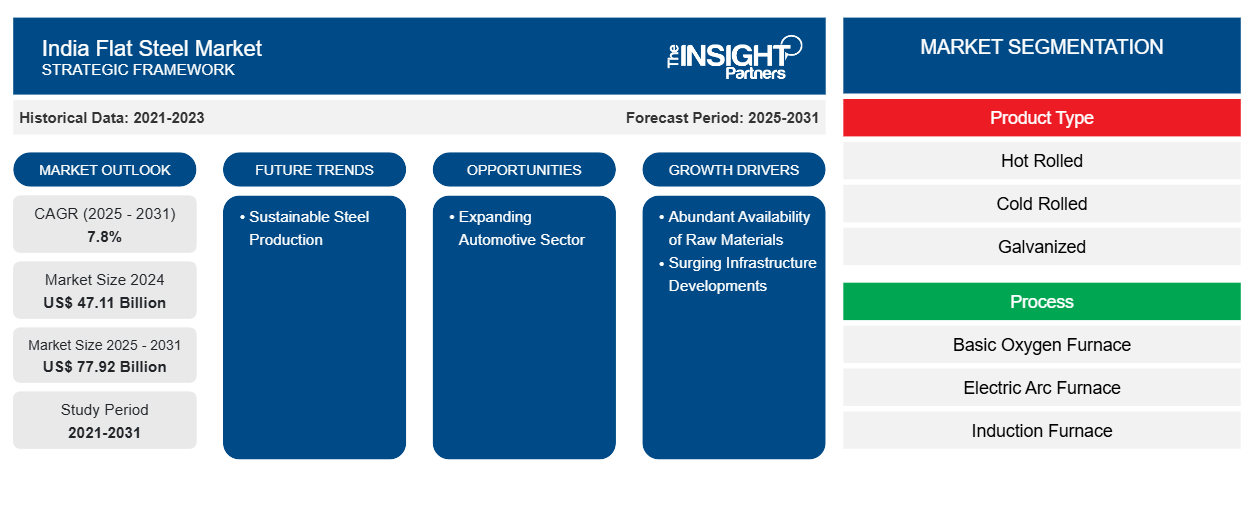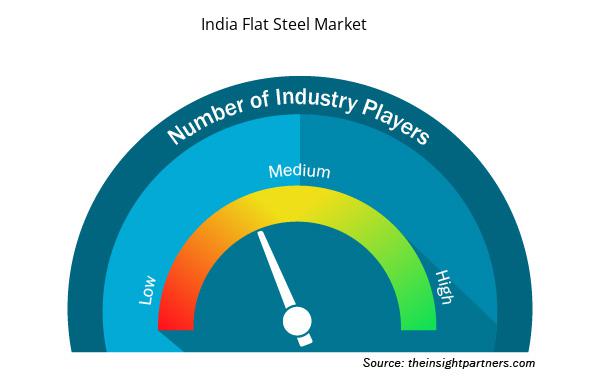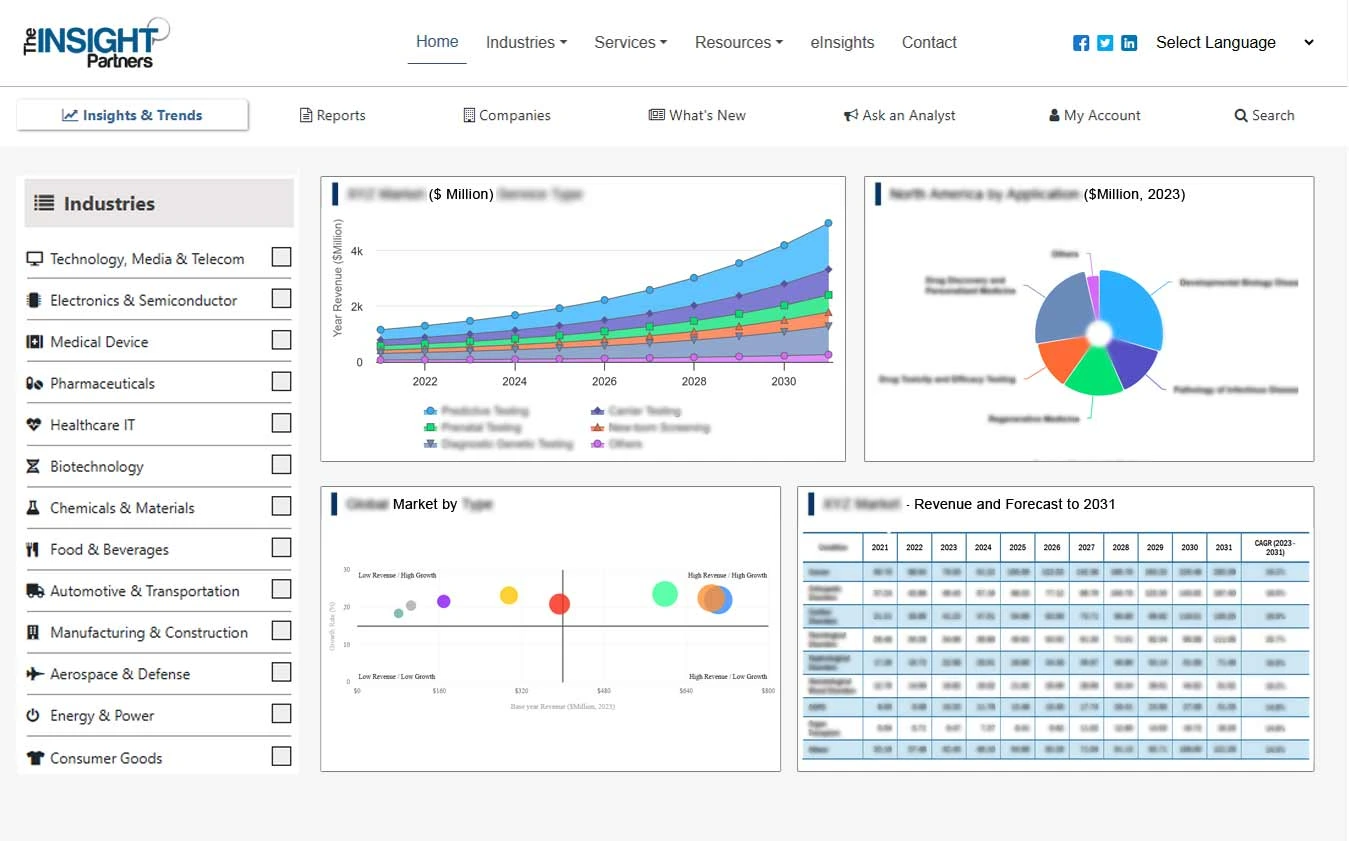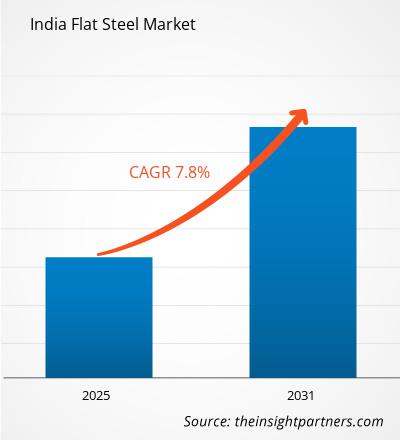印度扁平材市场规模预计将从2024年的471.1亿美元增长到2031年的779.2亿美元;预计2025年至2031年期间的复合年增长率将达到7.8%。对可持续钢铁生产日益增长的需求很可能成为未来市场的一个显著趋势。
印度扁平材市场分析
印度扁平材市场正因原材料供应充足和基础设施投资激增而不断扩张。据印度房地产开发商协会联合会 (Confederation of Real Estate Developers' Associations of India) 统计,古吉拉特邦已承诺建设9.1亿平方英尺的土地,并在2020-2023年获得房地产监管局 (RERA) 的注册。仅在2021-2022年,就有2.6亿平方英尺的开发项目在RERA注册。甘地讷格尔、艾哈迈达巴德、苏拉特、拉杰果德和瓦多达拉是该邦建筑业贡献最大的地区。这些地区在RERA注册的项目中占比82%,项目市场价值占比93%。这些终端应用行业的蓬勃发展刺激了古吉拉特邦对扁平材产品的需求。
印度扁平材市场概览
印度拥有规模最大的钢铁厂,为印度钢铁行业的发展做出了贡献。印度钢铁公司(SAIL)的博卡罗和鲁尔克拉钢厂以及塔塔钢铁公司的贾姆谢德布尔工厂是扁平材产品的主要生产商。奥里萨邦是钢铁生产中心,拥有众多钢厂,为印度钢铁总产量做出贡献。塔塔钢铁公司在奥里萨邦的梅拉曼达利工厂是印度最大的扁平材生产厂之一。2024年2月,JSW集团宣布计划在奥里萨邦建立一座钢厂,投资额为780万美元,年产能为1320万吨。这些邦产能的提升将有助于推动扁平材在印度的普及。
您可以免费定制任何报告,包括本报告的部分内容、国家级分析、Excel 数据包,以及为初创企业和大学提供优惠和折扣
印度扁平材市场:

- 获取此报告的顶级关键市场趋势。此免费样品将包括数据分析,从市场趋势到估计和预测。
印度扁平材市场驱动因素和机遇
基础设施建设蓬勃发展
据新闻信息局报道,公共基础设施是印度经济发展的支柱,有助于增强互联互通和全球贸易。政府的优惠举措和政策支持了该国的基础设施发展。2021年,印度政府启动了“总理加蒂·沙克蒂国家总体规划”,该规划汇集了包括公路和铁路在内的各部委,以确保协调执行和综合规划该国的基础设施项目。该倡议旨在为不同交通方式的货物、服务和人员流动提供无缝连接,从而增强“最后一英里”的连通性并缩短时间。
据同一来源称,印度拥有全球第二大公路网络,全国国家公路总长度将从2014年的91,287公里扩展到2024年的146,145公里,成为印度的主要交通干线网络。印度政府已采取措施,通过“印度道路建设计划”(Bharatmala Pariyojana)和“特别加速公路发展计划”(Special Accelerated Road Development Programme)加强和提升其国家公路网络。
扁钢嵌入混凝土中,用于路基、路面和挡土墙。这种加固措施可以提高承载能力、使用寿命和抗裂性,确保路面能够承受交通繁忙和环境压力。因此,中国基础设施建设的不断增加推动了对扁钢产品的需求。
不断扩张的汽车行业
由于国内产量不断上升,印度汽车行业正在扩张。企业对开拓农村市场兴趣高涨,促进了汽车行业的增长。物流和客运行业的增长推动了商用车需求。根据印度品牌资产基金会的数据,印度是全球最大的拖拉机生产国、第二大公共汽车生产国和第三大重型卡车生产国。该国汽车年产量从 2023 年的 2593 万辆增加到 2024 年的 2843 万辆。高端汽车制造商的销量有所增长。2024 年 12 月,梅赛德斯-奔驰股份公司在印度销售了 1,468 辆豪华汽车,在乘用车领域位居第一。印度电动汽车销量从 2023 年的 82,688 辆增加到 2024 年的 100,000 辆。根据印度储能联盟的数据,到 2026 年,印度电动汽车市场规模预计将增长 36%。
汽车制造商使用扁平轧制碳钢产品制造发动机部件,包括气缸体和曲轴。他们还制造悬架部件,例如支柱、弹簧和控制臂。扁平轧制碳钢坚固耐用,是汽车中承受压力的关键部件的理想选择。它还有助于减少排放并提高燃油效率。因此,汽车行业的蓬勃发展刺激了对扁平轧制碳钢产品的需求。
印度扁平材市场报告细分分析
有助于得出印度扁平钢市场分析的关键部分是产品类型、工艺类型、最终用途类别和最终用途行业。
- 根据产品类型,市场细分为热轧、冷轧、镀锌、涂层钢和其他类型。2024年,热轧钢占据了印度扁平材市场的最大份额。
- 按工艺流程,印度扁钢市场分为氧气顶吹转炉、电弧炉和感应炉。2024年,氧气顶吹转炉占据了印度扁钢市场的最大份额。
- 根据最终用途类别,市场分为原始设备制造商 (OEM) 和中小微企业 (MSME)。2024 年,中小微企业占据了更大的市场份额。
- 根据终端应用行业,市场细分为基础设施、太阳能、汽车、电气、船舶及其他。预计基础设施领域将在预测期内占据市场主导地位。
印度扁平材市场份额(按区域)分析
印度南部的人均钢铁消费量领先印度,这反映了其工业基础和基础设施的增长。该地区的钢铁生产依赖于铁矿石、直接还原铁 (DRI) 和废钢的混合,支持传统和绿色炼钢工艺。据印度钢铁部 (PIB) 的数据,截至 2024 年,成品钢总量为 2624 万吨。该地区的热轧、冷轧和镀锌钢产能正在扩大,以满足不断增长的基础设施、汽车和制造业需求,同时引领印度向更绿色的钢铁生产转型。据电子、信息技术和生物技术部的数据,卡纳塔克邦是印度第四大汽车制造商,约占印度总产量的 8.5%。
印度扁平材市场因有利的投资而不断增长。哈里亚纳邦是北部地区的主要产钢邦之一。2025年5月,主要生产镀锌卷、彩涂卷和冷轧钢的金达尔印度公司(Jindal India)扩大了其在哈里亚纳邦的涂层扁平材产能,目前年产量为300万吨,到2027年将增至420万吨。预计该公司2025年的扁平材产能将达到:热轧200-300万吨/年,冷轧100-200万吨/年,以及150-200万吨/年,这将推动印度北部地区对扁平材的需求。
印度扁平材市场区域洞察
Insight Partners 的分析师已详尽阐述了预测期内影响印度扁平材市场的区域趋势和因素。本节还讨论了印度扁平材市场在北美、欧洲、亚太、中东和非洲以及南美和中美的细分市场和地理位置。

- 获取印度扁平材市场的区域特定数据
印度扁平材市场报告范围
| 报告属性 | 细节 |
|---|---|
| 2024年的市场规模 | 471.1亿美元 |
| 2031年的市场规模 | 779.2亿美元 |
| 全球复合年增长率(2025-2031) | 7.8% |
| 史料 | 2021-2023 |
| 预测期 | 2025-2031 |
| 涵盖的领域 | 按产品类型
|
| 覆盖地区和国家 | 印度
|
| 市场领导者和主要公司简介 |
|
印度扁平材市场参与者密度:了解其对商业动态的影响
印度扁平材市场正在快速增长,这得益于终端用户需求的不断增长,而这些需求的驱动因素包括消费者偏好的转变、技术进步以及对产品优势的认知度的提升。随着需求的增长,企业正在扩大产品线,不断创新以满足消费者需求,并抓住新兴趋势,从而进一步推动市场增长。
市场参与者密度是指特定市场或行业内企业或公司的分布情况。它表明特定市场空间内竞争对手(市场参与者)的数量相对于其规模或总市值而言。
在印度扁平材市场运营的主要公司有:
- JSW钢铁有限公司
- 塔塔钢铁有限公司
- 金达尔钢铁电力有限公司
- 浦项制铁控股公司
- 安赛乐米塔尔新日铁印度公司
- 南梦宫工业私人有限公司
免责声明:以上列出的公司没有按照任何特定顺序排列。

- 获取印度扁平材市场主要参与者概览
印度扁平材市场新闻及近期发展
通过收集初步和二次研究后的定性和定量数据来评估印度扁平钢市场,其中包括重要的公司出版物、协会数据和数据库。
印度扁平材市场报告覆盖范围及交付成果
《印度扁平钢市场份额和预测(2021-2031)》报告对以下领域进行了详细的市场分析:
- 印度扁平材市场趋势及涵盖范围内所有主要细分市场的预测
- 印度扁平材市场趋势以及市场动态,例如驱动因素、限制因素和关键机遇
- 详细的波特五力模型和 SWOT 分析
- 印度扁平材市场分析涵盖主要市场趋势、国家框架、主要参与者、法规和最新市场发展。
- 行业格局和竞争分析,涵盖市场集中度、热点图分析、知名企业以及印度扁平材市场的最新发展
- 详细的公司简介
- 历史分析(2 年)、基准年、预测(7 年)及复合年增长率
- PEST 和 SWOT 分析
- 市场规模价值/数量 - 全球、区域、国家
- 行业和竞争格局
- Excel 数据集



Report Coverage
Revenue forecast, Company Analysis, Industry landscape, Growth factors, and Trends

Segment Covered
This text is related
to segments covered.

Regional Scope
North America, Europe, Asia Pacific, Middle East & Africa, South & Central America

Country Scope
This text is related
to country scope.
常见问题
The abundant availability of raw materials and surging infrastructure developments drive the market growth.
The market is expected to register a CAGR of 7.8% during 2025–2031.
Sustainable steel production is expected to emerge as a future trend in the market during the forecast period.
JSW Steel Ltd, Tata Steel Ltd, Jindal Steel & Power Ltd, Posco Holdings Inc, ArcelorMittal Nippon Steel India, Namco Industries Pvt Ltd, Shah Alloys Ltd, Asian Mills Pvt Ltd, Asian Tubes Pvt Ltd, and Asian Tubes Pvt Ltd CR Division are key players operating in the market.
The List of Companies - India Flat Steel Market
- JSW Steel Ltd
- Tata Steel Ltd
- Jindal Steel & Power Ltd
- Posco Holdings Inc
- ArcelorMittal Nippon Steel India
- Namco Industries Pvt Ltd
- Shah Alloys Ltd
- Asian Mills Pvt Ltd
- Asian Tubes Pvt Ltd
- Asian Tubes Pvt Ltd CR Division
The Insight Partners performs research in 4 major stages: Data Collection & Secondary Research, Primary Research, Data Analysis and Data Triangulation & Final Review.
- Data Collection and Secondary Research:
As a market research and consulting firm operating from a decade, we have published and advised several client across the globe. First step for any study will start with an assessment of currently available data and insights from existing reports. Further, historical and current market information is collected from Investor Presentations, Annual Reports, SEC Filings, etc., and other information related to company’s performance and market positioning are gathered from Paid Databases (Factiva, Hoovers, and Reuters) and various other publications available in public domain.
Several associations trade associates, technical forums, institutes, societies and organization are accessed to gain technical as well as market related insights through their publications such as research papers, blogs and press releases related to the studies are referred to get cues about the market. Further, white papers, journals, magazines, and other news articles published in last 3 years are scrutinized and analyzed to understand the current market trends.
- Primary Research:
The primarily interview analysis comprise of data obtained from industry participants interview and answers to survey questions gathered by in-house primary team.
For primary research, interviews are conducted with industry experts/CEOs/Marketing Managers/VPs/Subject Matter Experts from both demand and supply side to get a 360-degree view of the market. The primary team conducts several interviews based on the complexity of the markets to understand the various market trends and dynamics which makes research more credible and precise.
A typical research interview fulfils the following functions:
- Provides first-hand information on the market size, market trends, growth trends, competitive landscape, and outlook
- Validates and strengthens in-house secondary research findings
- Develops the analysis team’s expertise and market understanding
Primary research involves email interactions and telephone interviews for each market, category, segment, and sub-segment across geographies. The participants who typically take part in such a process include, but are not limited to:
- Industry participants: VPs, business development managers, market intelligence managers and national sales managers
- Outside experts: Valuation experts, research analysts and key opinion leaders specializing in the electronics and semiconductor industry.
Below is the breakup of our primary respondents by company, designation, and region:

Once we receive the confirmation from primary research sources or primary respondents, we finalize the base year market estimation and forecast the data as per the macroeconomic and microeconomic factors assessed during data collection.
- Data Analysis:
Once data is validated through both secondary as well as primary respondents, we finalize the market estimations by hypothesis formulation and factor analysis at regional and country level.
- Macro-Economic Factor Analysis:
We analyse macroeconomic indicators such the gross domestic product (GDP), increase in the demand for goods and services across industries, technological advancement, regional economic growth, governmental policies, the influence of COVID-19, PEST analysis, and other aspects. This analysis aids in setting benchmarks for various nations/regions and approximating market splits. Additionally, the general trend of the aforementioned components aid in determining the market's development possibilities.
- Country Level Data:
Various factors that are especially aligned to the country are taken into account to determine the market size for a certain area and country, including the presence of vendors, such as headquarters and offices, the country's GDP, demand patterns, and industry growth. To comprehend the market dynamics for the nation, a number of growth variables, inhibitors, application areas, and current market trends are researched. The aforementioned elements aid in determining the country's overall market's growth potential.
- Company Profile:
The “Table of Contents” is formulated by listing and analyzing more than 25 - 30 companies operating in the market ecosystem across geographies. However, we profile only 10 companies as a standard practice in our syndicate reports. These 10 companies comprise leading, emerging, and regional players. Nonetheless, our analysis is not restricted to the 10 listed companies, we also analyze other companies present in the market to develop a holistic view and understand the prevailing trends. The “Company Profiles” section in the report covers key facts, business description, products & services, financial information, SWOT analysis, and key developments. The financial information presented is extracted from the annual reports and official documents of the publicly listed companies. Upon collecting the information for the sections of respective companies, we verify them via various primary sources and then compile the data in respective company profiles. The company level information helps us in deriving the base number as well as in forecasting the market size.
- Developing Base Number:
Aggregation of sales statistics (2020-2022) and macro-economic factor, and other secondary and primary research insights are utilized to arrive at base number and related market shares for 2022. The data gaps are identified in this step and relevant market data is analyzed, collected from paid primary interviews or databases. On finalizing the base year market size, forecasts are developed on the basis of macro-economic, industry and market growth factors and company level analysis.
- Data Triangulation and Final Review:
The market findings and base year market size calculations are validated from supply as well as demand side. Demand side validations are based on macro-economic factor analysis and benchmarks for respective regions and countries. In case of supply side validations, revenues of major companies are estimated (in case not available) based on industry benchmark, approximate number of employees, product portfolio, and primary interviews revenues are gathered. Further revenue from target product/service segment is assessed to avoid overshooting of market statistics. In case of heavy deviations between supply and demand side values, all thes steps are repeated to achieve synchronization.
We follow an iterative model, wherein we share our research findings with Subject Matter Experts (SME’s) and Key Opinion Leaders (KOLs) until consensus view of the market is not formulated – this model negates any drastic deviation in the opinions of experts. Only validated and universally acceptable research findings are quoted in our reports.
We have important check points that we use to validate our research findings – which we call – data triangulation, where we validate the information, we generate from secondary sources with primary interviews and then we re-validate with our internal data bases and Subject matter experts. This comprehensive model enables us to deliver high quality, reliable data in shortest possible time.

 获取此报告的免费样本
获取此报告的免费样本